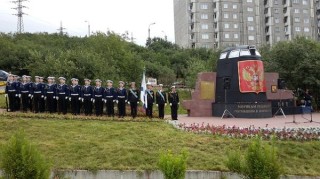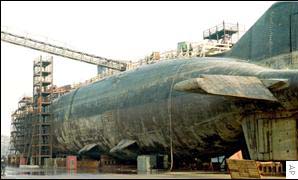
The system built to manage Russia’s nuclear legacy is crumbling, our new report shows
Our op-ed originally appeared in The Moscow Times. For more than three decades, Russia has been burdened with the remains of the Soviet ...
News

Publish date: August 12, 2014
Written by: Anna Kireeva
News
MURMANSK–Today, August 14, marks the 14 year anniversary of the sinking of the Kursk nuclear submarine, which went down after an explosion in a torpedo during Northern Fleet exercises in 2001, killing all 188 crew members on board despite the offers of numerous nations to aid in rescue efforts – which the Russian government rebuffed until it was too late.
Today, Murmansk, and the Northern Fleet submarine bases of Vidyayevo, Gadzhievo, Zaozersk, and Severodvinsk held memorial services dedicated to the anniversary of the vessel’s sinking.
The Kursk, or the K-141, was an Oscar Class cruise missile submarine. It was graved at Sevmash in 1992, and commissioned by the Russian Navy in December 1994. From 1995 to 2000, it was based at the port of Vidyayevo, and was considered one of the most powerful submarines in the Russian northern fleet.

The Kursk sank in the Barents Sea 175 kilometers from Severomorsk at a depth of 108 meters as the result of the torpedo explosion on board. All 118 crew members on board died – but not all at once. Some 20 survived on air in the read compartments of the vessel for several days while the Russian Navy bumbled several attempts to open the vessels escape hatch.
A Norwegian diving crew was finally allowed in and accomplished the opening of the hatch within minutes – something the Russian Navy could not accomplish in seven days. But it was too late. All sailors who had survived the initial blast had drowned.
Reasons behind the catastrophe
At the time, the Russian Navy forwarded a number of reasons – not all of them probably – for the disaster. One version had it that the Kursk had collided with an American submarine. Another asserted it had run into a still-active water mine from World War II.
After weeks of lies, the official version involving the torpedo explosion finally emerged and stuck, and was announced as the official version in 2002 by Russia’s then prosecutor general. Vladimir Ustinov.
“There is an official reason, and there are many that are just thought up,” said Alexander Nikitin, chairman of the St. Petersburg-based Environmental Rights Center (ERC) Bellona, himself a former submarine captain.
“I am inclined to believe the official version. Even specialists have spoken of the torpedo version with amazement – the slightest misstep can lead to tragedy,” he said.
In autumn of 2001, the Dutch salvage company Mammoet BV managed to lift the remains of the Kursk and transport them to the ship repair yard at Roslyakovo, a small village between Murmansk and Severomorsk. An investigative group combed over the Kursk’s remains for nearly six months. In April 2002, the shipwreck was transported to a floating dock at the Nerpa naval shipyard closer to Murmansk in order to remove its spend nuclear fuel.
Bellona closely followed the dismantlement process of the Kursk, and warned of possible ecological risks, specifically regarding the removal of the fuel elements for a reactor so terribly damaged by the explosion that sank the Kursk in the first place.

It was the first time in Russian naval history that spent fuel had to be removed from a submarine suffering such a catastrophic accident, which had laid at a depth of more than 100 meters for more than a year. Furthermore, Nerpa had previous to this never removed fuel from a submarine of the Kursk’s type or after such damage.
In 2003, Bellona sent a letter (in Russian) to Sergei Ivanov, Russia’s former Minister of Defense, requesting that Russia make public information surrounding submarine accidents both during the Soviet era and subsequently under Russia.
The tragedy’s lessons
According to Nils Bøhmer, Bellona’s general director and nuclear physicist, it’s not clear whether the Russian Navy managed to carry any lasting lessons at all away from the Kursk – especially when taking into account Russia’s huge new build-out of nuclear submarines, whose cost dwarfs the amount other nations spent in Russia to help it dismantle and safely handle its old ones.
“Fourteen years after the Kursk tragedy, it is still an open question as to how much the Russian Navy learned from this accident,” he said. “There is an increase activity with nuclear subamarines in the Barents Sea, and the question is not if there will be a new accident, but when.”
But Nikitin noted a slightly improved record with submarine accidents since the Kursk.
“For 14 years following the Kursk, there have been no serious catastrophes with submarines, aside from the K-159 which sank while under tow,” he said. “Before the Kursk, the periods of catastrophes [with submarines] was more intense.”
For example, in 1970, the K-8 sunk. In 1983, the K-429 also went down. That was followed in 1986 by the K-219, and in 1989 by the K-278.
“Today, the use of Russian submarines is far less intense than it was during the Cold War, but we all the same keep hearing that we are returning to a ‘chill,’ – implying that the intensity and quantity of nuclear submarines is going up,” said Nikitin. “What does this mean? Should we be keeping our eyes open for the next catastrophe? I would hope not, but it’s certainly an open question.”

Our op-ed originally appeared in The Moscow Times. For more than three decades, Russia has been burdened with the remains of the Soviet ...

The United Nation’s COP30 global climate negotiations in Belém, Brazil ended this weekend with a watered-down resolution that failed to halt deforest...

For more than a week now — beginning September 23 — the Zaporizhzhia Nuclear Power Plant (ZNPP) has remained disconnected from Ukraine’s national pow...

Bellona has taken part in preparing the The World Nuclear Industry Status Report 2025 and will participate in the report’s global launch in Rome on September 22nd.